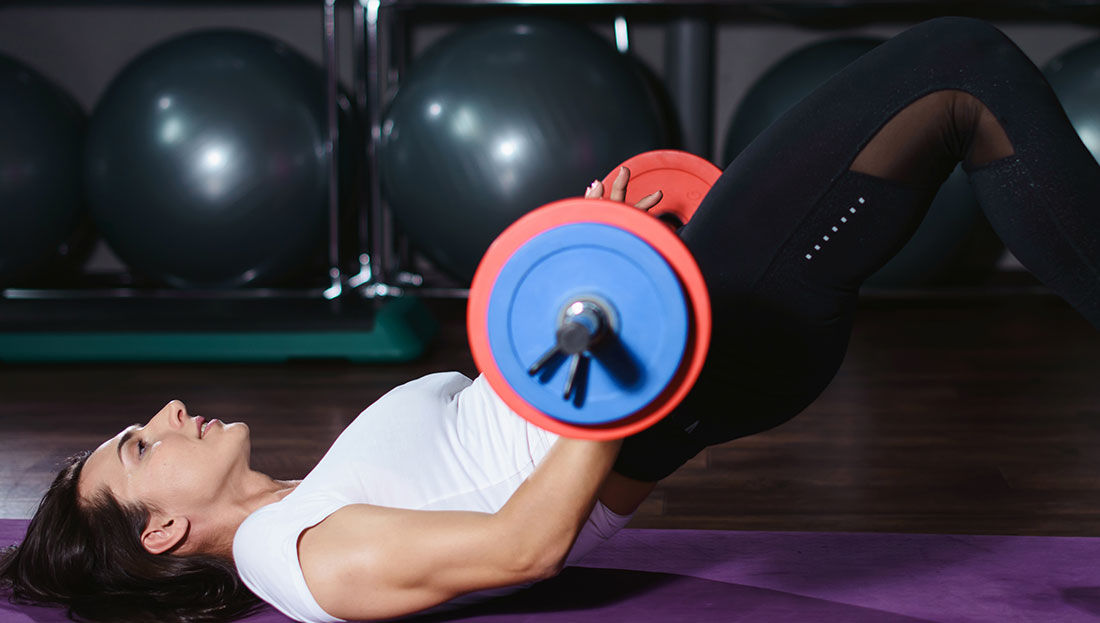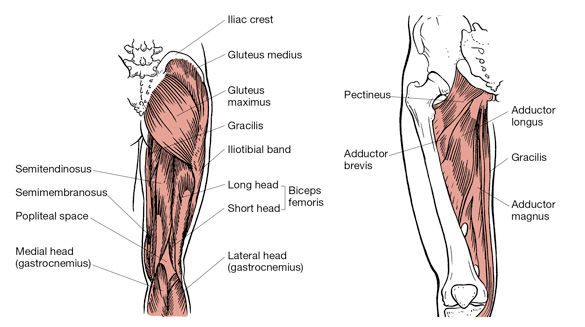
Walk into almost any fitness facility in the world and you are likely to see at least one person lying supine, with the shoulders on either the floor or part of a bench and a bar lying across the hips as he or she lowers the tailbone to the floor before pressing the hips upward toward the ceiling. This exercise is called the barbell hip thrust (BHT). It is not uncommon to see people performing this movement, often with other equipment such as dumbbells and kettlebells resting on the hips, or by using one of the newer machines designed to facilitate this exercise.
Which begs the question: Why has this exercise become so popular over the past few years? As with any trend, it can be difficult to pinpoint a single reason, but in this case, research suggests that this exercise offers numerous benefits, including enhanced hip strength and improved speed and acceleration.
An argument could be made that, when it comes to how we move, the hips may be the most important part of the body. After all, the hips are responsible for the ability to walk and run, and for controlling the movement of the body’s center of gravity. Likewise, the muscles that control the movement of the hips could be considered the most important muscles in the body. The muscles that extend the hips, specifically the larger muscles of the gluteus maximus, biceps femoris, semimembranosus, semitendinosus and adductor magnus, all play an important role in improving movement skill and improving athletic performance.

Additionally, strong hip extensors are important for maintaining balance and making it easier to perform everyday tasks, particularly as we grow older. Thus, when it comes to clients’ fitness goals, exercises that strengthen the hips, especially the muscles responsible for extension, are in high demand.
The Origins of the Hip Thrust
The BHT is basically a glute or hip bridge exercise with external resistance. The exercise involves lying face-up on the floor, or with the shoulders resting on a bench, with the knees bent and feet flat on the floor. The exerciser places a barbell across the top of the hips (usually on a pad) and presses the hips upward for a number of repetitions. This exercise focuses specifically on the hip extensor muscles of the gluteal complex, namely the gluteus minimus, gluteus medius and gluteus maximus.
The BHT can be performed with a variety of external resistance, including barbells, dumbbells or kettlebells, by placing them directly on the hips. However, study participants have complained about the discomfort of performing the BHT exercise, particularly when using heavier loads across the tops of the hip joints. (Delgado et al., 2019). Equipment companies have just begun developing machines that can facilitate the movement in a more comfortable position and without a barbell compressing the anterior superior iliac spine of the pelvis. Among the equipment developed for the hip thrust are the Hip Thruster and Thruster Bench (which still requires a barbell), Booty Builder, Glute Builder and Glute Drive.
Access to these machines, however, remains relatively limited. As a result, some people attempt to do the hip thrust on equipment such as the prone hamstring curl machine. This is not advised, however, because machines are designed for a specific purpose or movement pattern. “Hacking” an exercise machine—using it in a way it’s not designed for—can result in injury.
What the Research Says About the Hip Thrust
The BHT is unique in that it keeps the involved muscles under tension during the entire range of motion of the movement, which can help increase the time under tension responsible for promoting muscular development. In addition to using the BHT with his clients, Bret Contreras, who earned his doctoral degree in part based on research on the BHT, participated in formal investigations to examine the effectiveness of the exercise. He and his colleagues concluded that the BHT could be more effective for increasing activation of the hip extensor muscles when compared to more established exercises such as the barbell squat, deadlift or Romanian deadlift (Contreras et al., 2017).
One reason why the BHT is so effective for the glutes is that in the supine position, the gluteal muscles are placed under constant tension during the entire range of motion, from the bottom of the movement, when the hips are flexed and under load, to the top of the movement, when the hips are fully extended (Contreras, Cronin and Schoenfeld, 2011). Additionally, due to the supine position of the body, the direction of the resistive force is directly on the gluteus maximus and other muscles that extend the hips. This serves to increase the activation of those muscles while reducing the contribution of other muscles such as the hamstrings, adductors and quadriceps.
When the weight is resting on the hips, it creates different muscle activation patterns than when a weight is placed on top of the spine, such as in the barbell squat, or when picked up from the floor, as in the barbell deadlift. Studies that have compared how the BHT, squat and deadlift activate hip extensor muscles have consistently shown that the BHT can increase tension and activation of the glutes when compared to the other movements (Bezodis, Needham and Brazil, 2018; Williams et al., 2018; Contreras et al., 2017; Contreras, Cronin and Schoenfeld, 2011).
When selecting exercises as part of effective program design there may be more to consider than what muscle group is targeted. Body position, placement of resistance, force application, and the role of synergist muscles may make one exercise more appropriate than another. For example, the barbell squat places the load of the weight on top of the body so the force is going directly down, which requires the hamstrings and quadriceps to assist with knee and hip extension to return to the starting position. The deadlift starts with the weight on the floor and must be pulled up from the floor, which means that, like the squat, other muscles are required to help control motion of the knees during the exercise. Because the quadriceps and gluteus maximus work together to extend the knees and hips simultaneously, the squat and deadlift exercises may be more effective for people who want to strengthen both sets of muscles at the same time. For individuals who want to focus specifically on the hip extensors or who have knee or back discomfort that restricts the ability to perform standing exercises for the lower body, the evidence suggests that the BHT is an effective solution (Delgado et al., 2019).
During the squat exercise, evidence has shown that there is delayed hip extensor activation when compared to the deadlift and BHT, with glute activation at a minimum during the last 5 degrees of the movement (Bezodis, Needham and Brazil, 2018). This means that at the top of the movement, when the hips are in full extension, there is minimal contribution from those muscles. By comparison, when the hips are in full extension during the BHT, the weight is directly on top of the joint, which increases the load on the muscles responsible for hip extension and results in increased muscle activity (Bezodis, Needham and Brazil, 2018; Collazo Garcia et al., 2018; Williams et al., 2018; Contreras et al., 2017). According to Bezodis, Needham and Brazil (2018), “The largest and most meaningful differences in the hip moment occurred in the last 10% of the lifting phase, as the hip came toward full extension in each of the three lifts. At this time, the BHT elicited a greater hip extensor moment than the deadlift, which, in turn, elicited a greater moment than the back squat.”
Performance Enhancement Benefits of the BHT
In addition to enhancing overall strength and appearance of the glutes, the same anterior-posterior forces that create optimal activation of the glutes at the end of hip extension during the BHT can also help increase the amount of horizontal forces generated into the ground during a sprint. What does this mean? The hip thrust could be useful for helping athletes improve speed and acceleration, which are important motor skills when every meter or second counts (Contreras et al., 2017; Williams et al., 2018).
Looking at the BHT, the horizontal force vector of how the gluteal muscles are used to create hip extension is similar to the horizontal forces at the hips when sprinting at a high rate of speed. This is distinct from the squat or deadlift, where the force of muscle contraction creates vertical rather than horizontal motion of the hips. During the acceleration phase of sprinting, the hip extensors create a horizontal force to push off against the ground. Additionally, ground contact during sprinting occurs with the hip in a neutral to slightly extended position, with the glutes being the biggest contributor to hip extension torque. This results in a position-specific muscle force that is not replicated by traditional barbell squatting (Williams et al., 2018). In a separate examination of the movements, Contreras and colleagues observed that, “Squats may not be as beneficial for developing end-range hip extension strength as exercises that do emphasize such a complete range of motion” (Contreras et al., 2017).
The Bottom Line
The current popularity of the BHT could be attributed to a variety of factors, but the fact that it is so effective for engaging the glutes and hip extensors is likely near the top of the list. Research suggests that this exercise offers numerous benefits for a wide range of clients—from the college sprinter to the active ager—and that adding the BHT to your fitness toolbox is not about following the latest trends—it simply makes sense.
References
Bezodis, I., Needham, L. and Brazil, A. (2018). A comparison of hip joint kinetics during the barbell hip thrust, deadlift and back squat. 36th Conference of the International Society of Biomechanics in Sports. Auckland, New Zealand: NMU Commons.
Collazo Garcia, C.L et al. (2018). Differences in the electromyographic activity of lower-body muscles in hip-thrust variations. The Journal of Strength and Conditioning Research, e-pub ahead of print.
Contreras, B. et al. (2017). Effects of a six-week hip thrust vs. front squat resistance training program on performance in adolescent males: A randomized controlled trial. Journal of Strength and Conditioning Research, 31, 4, 999−1008.
Contreras, B., Cronin, J. and Schoenfeld, B. (2011). Barbell hip thrust. Strength and Conditioning Journal, 33, 5, 58−61.
Delgado, J. et al. (2019). Comparison between back squat, Romanian deadlift and barbell hip thrust for leg and hip muscle activities during hip extension. The Journal of Strength and Conditioning Research, 33, 10, 2595−2601.
Williams, M. et al. (2018). Activation of the gluteus maximus during performance of the back squat, split squat, and barbell hip thrust and the relationship with maximal sprinting. Journal of Strength and Conditioning Research, e-pub ahead of print.





 by
by 



